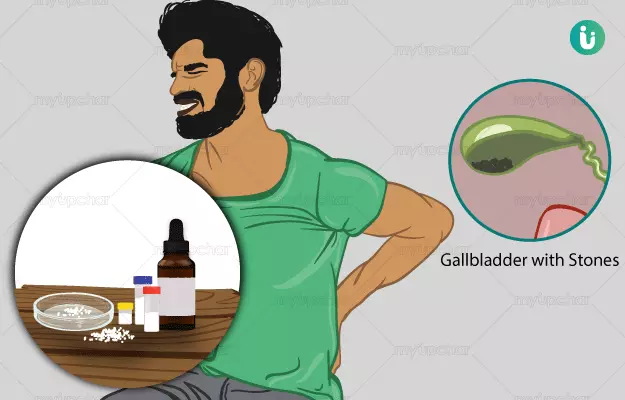Gallbladder is a small pouch-like organ that lies below and behind the liver. Its primary function is to store and concentrate bile produced by the liver to help digest fats and secrete it into the small intestine where digestion of fats takes place. Due to an excess of cholesterol, bilirubin or calcium salts in bile, hard deposits are formed in the gallbladder, these are also called as biliary calculi or gallbladder stones. Gallbladder stones are common in adults, particularly in women aged above 40. The condition generally does not show any symptoms until the deposits are significant and result in the blockage of bile duct.
Common symptoms, which start to show up once the condition escalates are:
- Jaundice
- Fever
- Pain in the right and upper abdominal region, which can last for hours
- Sudden pain after a fatty meal
- Loss of appetite and diarrhoea
Conventionally, either medicines or surgery is advised for removal of gallbladder stones. This depends on the size of the stone. Medicines are usually prescribed for dissolving smaller stones; however, these medicines are rarely very effective and there is a risk of recurrence of stones once the treatment is stopped. In such cases and for large stones, surgery is the most viable option.
Homeopathy provides a better alternative with negligible need for surgery. Remedies like carduus marianus, calceria carbonica, fel tauri and several others have been used successfully for treating gallbladder stones without any reported cases of recurrence.
- Homeopathic medicines for gallbladder stones
- Dietary and lifestyle changes for gallbladder stone patient as per homeopathy
- How effective are homeopathic medicines and treatments for gallbladder stones
- Side effects and risks of homeopathic medicine and treatments for gallbladder stones
- Takeaway
Homeopathic medicines for gallbladder stones
- Baptisia Tinctoria
Common name: Wild indigo
Symptom: This remedy is commonly used in cases of typhoid. Common symptoms, which are relieved by this remedy are:
The condition often tends to get worse by staying indoors and in hot and humid conditions. Foggy weather also results in gallbladder colic.
- Berberis Vulgaris
Common name: Barberry
Symptoms: Berberis vulgaris is commonly prescribed in conditions of pain around the kidney region and symptoms related to bile flow. Other symptoms, for which this remedy is prescribed, are:- Stitching pain around the region of gallbladder
- Pain emerging from around the liver area and extending to the stomach
- Yellow complexion i.e. jaundice
- Constipation
These conditions can also result in symptoms related to the urinary system. Symptoms worsen on standing or with any kind of motion.
- Bryonia Alba
Common name: Wild hops
Symptoms: Bryonia alba is generally prescribed for treating pain, which worsen with movement. It is well suited to dark-complexioned individuals and works best in the evening in warm airy places. Common symptoms, which indicate a need for this remedy are:- Swelling around the liver region
- Burning sensation with pain around the abdomen
- Pain that is worse in the morning with constipation
Individuals suffering from this condition typically experience increased pain during the morning, in hot weather and with exertion, while cold and slight pressure help in relieving the pain.
- Carduus Marianus
Common name: St. Mary’s thistle
Symptoms: Carduus marianus is a common medication used in jaundice and symptoms related to the liver. It also helps relieve the following symptoms:- Pain in the liver region
- Constipation alternating with diarrhoea
- Pain and swelling of the gallbladder
- Calcarea Carbonica
Common name: Carbonate of lime
Symptoms: This remedy is prescribed to people who tend to catch a cold easily and are obese with pale skin. Common symptoms shown by such individuals are:- Abdomen sensitive to pressure
- Pain in the liver region even with the slightest pressure
- Gallstone colic (severe crampy pain)
- Swelling and excruciating pain in the abdominal region
Pain increases in cold weather or on consumption of anything cold. Dry climate eases the pain.
- Chelidonium Majus
Common name: Celandine
Symptoms: Chelidonium majus is a commonly prescribed remedy for jaundice and diseases related to the liver. Common symptoms that are relieved by this remedy are:- Gallbladder colic
- Swelling of the gallbladder and around the liver region
Severity of the condition increases in mornings and with a change in weather. The individual typically feels better after dinner and when slight pressure is applied to the region.
- Cholesterinum
Common name: Cholesterine
Symptoms: Symptoms that typically indicate a need for this remedy are:- Burning pain around the abdominal region
- Jaundice
- Pain due to stones in the gallbladder
- Fel Tauri
Common name: Ox gall
Symptoms: Individuals who benefit from this remedy experience some of the following symptoms:- Pain due to obstruction of the bile duct
- Jaundice
- Diarrhoea
- Juglans Cinerea
Common name: Butternut
Symptoms: Butternut is an effective remedy for jaundice. Common symptoms, for which juglans cinerea is prescribed, are:- Abdominal pain, especially around the liver region
- Diarrhoea
Individuals who respond to this remedy tend to feel at ease in warm environment and in the mornings. Walking, however, results in increased pain.
- Leptandra Virginica
Common name: Culver’s root
Symptoms: This remedy helps relieve the following symptoms:- Increased sensitivity in area surrounding the liver
- Pain around the abdomen
- Jaundice
- Myrica Cerifera
Common name: Bayberry
Symptoms: This medicine is commonly prescribed for symptoms related to the liver. Other symptoms that can be treated with Myrica Cerifera are:- Prolonged dull pain in the abdomen
- Jaundice
- Scanty, yellow, foamy urine
- Medorrhinum
Common name: The gonorrheal virus
Symptoms: Common symptoms which indicate a need for medorrhinum are:- Excruciating pain in the liver region
- Craving for sweets
- Forgetfulness
- Pain that is relieved by lying on the abdomen
People who respond to medorrhinum often experience worsening of symptoms when thinking about their condition. Pain is often experienced during the day and gets better as the sun sets. Damp and cold weather, and being at seashores calm the pain.
- Ptelea Trifoliata
Common name: Wafer ash
Symptoms: Common symptoms experienced by an individual who benefits from this remedy are:- Liver conditions
- Pain in the right side of abdomen
- Reduction in pain while lying on the right side of the abdomen
- Pain and swelling of the liver with sensitivity to pressure
An individual benefitting from this prescription typically experiences worsening of symptoms during the morning or when lying on the left side. Eating sour foods helps in relieving the pain.
Dietary and lifestyle changes for gallbladder stone patient as per homeopathy
According to a survey, North India has a high incidence of gallbladder stones, which increases the risk of gallbladder cancer. The survey reported that factors such as the diet and lifestyle of people significantly influence the occurrence of gallbladder stones. Homeopathic treatment includes certain lifestyle modifications to prevent the formation of, and aid in the treatment of existing gallstones. These also help reduce the interference of external factors, while the treatment is going on.
Do’s
- Consume fresh foods that are low in fat and rich in iron
- Living conditions and temperature should be maintained according to the individual’s comfort
- Good personal hygiene and cleanliness of the surroundings should be maintained
Don’ts
- Beverages with high caffeine content and alcoholic drinks should be avoided
- Excess of sour or hot foods should be avoided as they hinder the working of homeopathic medicines
- Rough or tight-fitting clothes are advised against because the region overlying the liver tends to be sensitive in several cases
- Living conditions and temperatures that the individual is not accustomed to or comfortable in should be avoided
How effective are homeopathic medicines and treatments for gallbladder stones
Homeopathic medicine has been found to be highly effective for the treatment of gallbladder stones. The ability of homeopathic remedies to heal the body and not merely the condition results in remarkably positive results in most of the cases. The basic principle of homeopathy is ‘like cures like’. These remedies are prepared from diluted quantities of substances, which, in higher concentrations, cause the same set of symptoms in a healthy person.
A homeopathic practitioner writes a prescription only after an extensive examination of all the symptoms of the individual along with his/her appearance, mental state and medical as well as family history. The purpose of this extensive analysis is to prescribe the best-suited remedy, which has no side effects on the individual.
According to a case study, a 48-year-old man with episodes of gallstone colic was advised surgery by his allopathic physician. Not wanting surgery, the individual sought homeopathic treatment and was completely cured within 6 months with no signs of any side effects during or after treatment.
In another study, a 54-year-old Indian man with gallbladder stones experienced complete resolution of symptoms with no side effects or signs of existing gallbladder stones following treatment with medorrhinum for 4 months.
Side effects and risks of homeopathic medicine and treatments for gallbladder stones
The holistic approach of homeopathy makes it almost impossible for any side effects to occur. Moreover, the fact that all homeopathic remedies are obtained from natural substances dramatically decreases the chances of side effects compared to other forms of treatment.
The safety and efficiency of homeopathic remedies has also been ascertained by clinical studies. In particular, a study reported complete cure of gallbladder stones with homeopathic remedies such as medorrhinum with no signs of any side effects.
However, for the sake of safety, it is always best to check in with a doctor before taking any remedy at home as not all remedies affect every individual alike and wrong or higher dosage may lead to secondary effects.
Takeaway
Gallbladder stones are a common occurrence in a wide range of population; however, a majority of the affected individuals remain asymptomatic until complications develop. Nonetheless, there are several medications and methods to treat this condition.
In general, conventional medicine recommends surgery as the treatment of choice because medications do not guarantee a permanent cure without recurrence. Homeopathy, on the other hand, has tried-and-tested remedies tailored for every symptom of this condition. In numerous cases of gallbladder stones, homeopathy has been a very effective and safe option with complete resolution of stones and no signs of recurrence or medication side effects.
Homeopathic medicines like medorrhinum, fel tauri and calcarea carbonica are effective and reliable choices for the treatment of gallbladder stones and its symptoms.
Find Homeopathic Doctor in cities
Doctors for Homeopathic medicine, treatment and remedies for Gallbladder Stones

Dr. Rutvik Nakrani
Homeopathy
6 Years of Experience

Dr. Jyothi
Homeopathy
23 Years of Experience

Dr. Urvashi Chaudhary
Homeopathy
8 Years of Experience

Dr. Anita Kumari
Homeopathy
12 Years of Experience
References
- National Health Service [Internet]. UK; Overview - Gallstones
- National Health Service [Internet]. UK; Treatment - Gallstones
- The Homopatheticcollege. Victory Over Serious Conditions: Gallstone Colic. [Internet]
- Madhu Sudan Ghosh. A case of gallstone with prostatomegaly. Year : 2014 Volume : 8 Issue : 4 Page : 231-235
- Madhu Sudan Ghosh. A case of gallstone with prostatomegaly. Year : 2014 Volume : 8 Issue : 4 Page : 231-235
- William Boericke. Homoeopathic Materia Medica. Kessinger Publishing: Médi-T 1999, Volume 1
- Sayeed Unisa et al. Population-based study to estimate prevalence and determine risk factors of gallbladder diseases in the rural Gangetic basin of North India. HPB (Oxford). 2011 Feb; 13(2): 117–125. PMID: 21241429
- Sayeed Unisa et al. Population-based study to estimate prevalence and determine risk factors of gallbladder diseases in the rural Gangetic basin of North India. HPB (Oxford). 2011 Feb; 13(2): 117–125. PMID: 21241429
- Wenda Brewster O’Reilly. Organon of the Medical art by Wenda Brewster O’Reilly. B jain; New Delhi







